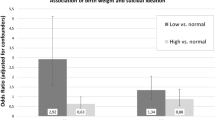Abstract
Barry and Barry1 observed in a sample of American schizophrenics an over-representation of first borns in small sibships and later borns in large ones. On this evidence they hypothesized that the more severe pressure of parental expectation on first borns of small sibships and the relative parental rejection of later borns in large ones might contribute to the development of schizophrenia in adult life. Erlenmeyer-Kimling et al.2 reported that the same trend was observed about as frequently in studies of non-schizophrenics, and Price and Hare3 suggested reasons for such a trend being present in the British population as a whole and demonstrated it in a large sample of non-schizophrenic patients4. They noted that the extent of the deviation varied with year of birth. They later showed that the birth rank distribution of a large sample of British schizophrenics differed significantly from that of a sample of neurotics, having the same year of birth distribution and which they assumed to be representative of the general population5. In sibships of two to four there was a comparative excess of schizophrenics in the later birth ranks. Hinshelwood6 attempted to explain this finding by postulating that, in schizophrenia, there is a specific over-representation of the penultimate birth rank. To account for the vulnerability of the penultimate sibling he revived Adler's “dethroned monarch” theory, suggesting that an unwanted last child may be an especial trauma to its predecessor. He summed data of six previous studies (four American, one Canadian and one British), and demonstrated in the total sample an over-representation of the last-but-one position. Hare and Price7 considered this to be a chance effect of combining studies carried out at different times and in different countries. Hinshelwood should be further criticized for combining data on patients diagnosed as schizophrenic in America and Britian. A recent patient8 was videotaped and diagnosed as schizophrenic by 69% of American psychiatrists but only 2% of British ones. The latest study of Hare and Price5 is far from conclusive for, as Barry and Barry9 have correctly pointed out, a sample of neurotics, or of any other non-schizophrenic patients, may well differ from the general population by birth rank distribution.
This is a preview of subscription content, access via your institution
Access options
Subscribe to this journal
Receive 51 print issues and online access
$199.00 per year
only $3.90 per issue
Buy this article
- Purchase on Springer Link
- Instant access to full article PDF
Prices may be subject to local taxes which are calculated during checkout
Similar content being viewed by others
References
Barry, H., III, and Barry, jun., H., Arch. Gen. Psychiat., 17, 435 (1967).
Erlenmeyer-Kimling, L., Van Den Bosch, E., and Denham, B., Brit. J. Psychiat., 115, 659 (1969).
Price, J. S., and Hare, E. H., Brit. J. Psychiat., 115, 633 (1969).
Hare, E. H., and Price, J. S., Brit. J. Psychiat., 115, 647 (1969).
Hare, E. H., and Price, J. S., Brit. J. Psychiat., 116, 409 (1970).
Hinshelwood, R. D., Brit. J. Psychiat., 117, 293 (1970).
Hare, E. H., and Price, J. S., Nature, 228, 1223 (1970).
Copeland, J. R. M., Cooper, J. E., Kendell, R. E., and Gourlay, A. J., Brit. J. Psychiat., 118, 629 (1971).
Barry, H., III, and Barry, H., jun., Nature, 231, 57 (1971).
Greenwood, M., and Yule, G. U. J., Roy. Stat. Soc., 77, 179 (1914).
Author information
Authors and Affiliations
Rights and permissions
About this article
Cite this article
BIRTCHNELL, J. Birth Rank and Mental Illness. Nature 234, 485–487 (1971). https://doi.org/10.1038/234485a0
Received:
Revised:
Issue Date:
DOI: https://doi.org/10.1038/234485a0
This article is cited by
-
The Sex Ratio of Older Siblings in Non-Right-Handed Homosexual Men
Archives of Sexual Behavior (2008)
-
Birth order and sibling sex ratio in two samples of Dutch gender-dysphoric homosexual males
Archives of Sexual Behavior (1996)
-
Early and current factors associated with poor-quality marriage
Social Psychiatry (1983)
-
Birth order and mental illness
Social Psychiatry (1972)
Comments
By submitting a comment you agree to abide by our Terms and Community Guidelines. If you find something abusive or that does not comply with our terms or guidelines please flag it as inappropriate.



